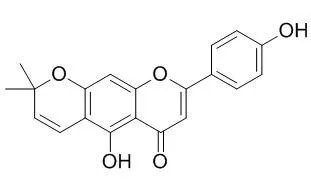| In vitro: |
| J Agric Food Chem. 2013 Nov 20;61(46):11008-15. | | Bioassay guided isolation and identification of anti-inflammatory active compounds from the root of Ficus formosana.[Pubmed: 24200240] | Activity-directed fractionation and purification processes were employed to identify the anti-inflammatory active compounds using lipopolysaccharide (LPS)-stimulated mouse macrophage (RAW264.7) in vitro.
METHODS AND RESULTS:
Air-dried roots of Ficus formosana were extracted with methanol and separated into n-hexane, chloroform, ethyl acetate, n-butanol, and water layers. Among them, the chloroform layer showed strong activity and was subjected to separation and purification by using various chromatographic techniques. Five compounds showing potent activity were identified by comparing spectral data to be β-sitosterol, stigmasterol, psoralen, kaempferol, Carpachromene, and syringic aldehyde. When macrophages were treated with psoralen and kaempferol together with LPS, a concentration-dependent inhibition of nitric oxide (NO) and tumor necrosis factor (TNF-α) productions were detected. Western blotting revealed that kaempferol, psoralen, and Carpachromene blocked protein expression of inducible nitric oxide synthase (iNOS) and cyclooxygenase-2 (COX-2) in LPS-stimulated macrophages.
CONCLUSIONS:
The results confirmed that the traditional use of F. formosana could be a potential anti-inflammatory agent. | | Mol Nutr Food Res. 2008 Dec;52(12):1530-8. | | Isolation of tyrosinase inhibitors from Artocarpus heterophyllus and use of its extract as antibrowning agent.[Pubmed: 18683821 ] | A new furanoflavone, 7-(2,4-dihydroxyphenyl)-4-hydroxy-2-(2-hydroxy propan-2-yl)-2, 3-dihydrofuro(3, 2-g)chromen-5-one (artocarpfuranol, 1), together with 14 known compounds, dihydromorin (2), steppogenin (3), norartocarpetin (4), artocarpanone (5), artocarpesin (6), artocarpin (7), cycloartocarpin (8), cycloartocarpesin (9), artocarpetin (10), brosimone I (11), cudraflavone B (12), Carpachromene (13), isoartocarpesin (14), and cyanomaclurin (15) were isolated from the wood of Artocarpus heterophyllus.
METHODS AND RESULTS:
Their structures were identified by interpretation of MS,( 1)H-NMR,( 13)C-NMR, HMQC, and HMBC spectroscopic data. Among them, compounds 1-6 and 14 showed strong mushroom tyrosinase inhibitory activity with IC(50) values lower than 50 microM, more potent than kojic acid (IC(50) = 71.6 microM), a well-known tyrosinase inhibitor. In addition, extract of A. heterophyllus was evaluated for its antibrowning effect on fresh-cut apple slices. It was discovered that fresh-cut apple slices treated by dipping in solution of 0.03 or 0.05% of A. heterophyllus extract with 0.5% ascorbic acid did not undergo any substantial browning reaction after storage at room temperature for 24 h. The antibrowning effect was significantly better than samples treated with the extract (0.03 or 0.05%) or ascorbic acid (0.5%) alone.
CONCLUSIONS:
The results provide preliminary evidence supporting the potential of this natural extract as antibrowning agent in food systems. |
|






 Cell. 2018 Jan 11;172(1-2):249-261.e12. doi: 10.1016/j.cell.2017.12.019.IF=36.216(2019)
Cell. 2018 Jan 11;172(1-2):249-261.e12. doi: 10.1016/j.cell.2017.12.019.IF=36.216(2019) Cell Metab. 2020 Mar 3;31(3):534-548.e5. doi: 10.1016/j.cmet.2020.01.002.IF=22.415(2019)
Cell Metab. 2020 Mar 3;31(3):534-548.e5. doi: 10.1016/j.cmet.2020.01.002.IF=22.415(2019) Mol Cell. 2017 Nov 16;68(4):673-685.e6. doi: 10.1016/j.molcel.2017.10.022.IF=14.548(2019)
Mol Cell. 2017 Nov 16;68(4):673-685.e6. doi: 10.1016/j.molcel.2017.10.022.IF=14.548(2019)